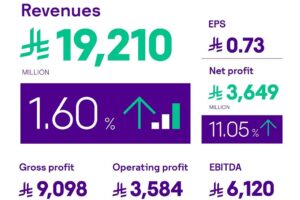By: Khalid Athar
Experts agree that research and development (R&D) is the backbone of a competitive, knowledge-driven economy. R&D investments help develop new products and services that drive growth, create jobs, and meet the future demands of societies and nations.
Regional governments have taken significant steps to incorporate innovation into their national agendas to drive socio-economic growth. For example, the UAE’s R&D Governance Policy announced in 2021 established the Emirates Research and Development Council. In addition, a National Guide for Measurement of R&D Expenditures in the Government Sector has been launched, and an Advanced Technology Research Council was established. Meanwhile, Saudi Vision 2030 targets at least five universities in 200 world best universities rankings, focusing on research and development as a key driver towards this end.
A significant focus for this R&D drive is nurturing an advanced ICT sector, whose success is key to addressing societal challenges, supporting economic recovery, raising the bar in commercial competitiveness, and opening new revenue streams for businesses.
The region can borrow a leaf from China in this endeavor, a country that has quickly transitioned from a cost-driven manufacturing hub to an innovation-driven economy. The Asian country rose from 29th in the Global Innovation Index in 2015 to 14th in 2020 and fourth to first in patent registrations over the same period.
Two sectors stand out in China’s technology R&D primacy and innovation – A.I. and 5G.
China is quickly closing the once-formidable lead the U.S. maintained on A.I. research. Chinese researchers now publish more papers on A.I. and secure more patents than their U.S. peers and the country is poised to become a leader in AI-empowered businesses. China also accounted for nearly one-fifth of global private investment funding in 2021, attracting $17 billion for A.I. startups.
In 5G, China dominates in both scale and innovation. The country has built the industry’s most extensive 5G mobile infrastructure, with 1.43 million 5G base stations rolled out as of 2021, accounting for over 60% of the global total. With such investments, Chinese operators have been critical drivers of 5 G’s progress globally.
China did not stop at 5G and will likely lead in the 6G evolution as well. 5G had only started rolling out when the country announced a 6G strategy in 2019, even before industry standards or definitions had been established. The country has led the 6G race ever since. A report by Nikkei shows that China topped the list with 40.3% of 6G patent filings, well ahead of the U.S. with 35.2%. For example, a Chinese government-backed institute, Purple Mountain Laboratories, announced earlier this year that it had achieved a 6G wireless transmission up to a speed of 206.25 gigabits per second for the first time in a lab environment.
Chinese-headquartered companies have followed suit, with Huawei leading the innovation race. Between 2009 and 2013, Huawei invested more than $600 million into 5G technology research, followed by a further $1.4 billion into 5G product development in 2017 and 2018. Overall, Huawei invests more in R&D than any of its competitors. Huawei’s R&D expenditure reached $22.4 billion in 2021, representing 22.4% of total revenue and bringing its total R&D expenditure over the past ten years to over $132.5 billion. In terms of R&D expenditure, Huawei ranked second in the 2021 EU Industrial R&D Investment Scoreboard. Furthermore, in 2021, Huawei had about 107,000 employees, representing approximately 54.8% of the entire workforce, working in R&D. Today, Huawei maintains one of the largest patent portfolios globally; by 2021, Huawei held more than 110,000 active patents across over 45,000 families. In 5G investments, Huawei had signed 50 5G commercial contracts and had 150,000 base station shipments by July 2019Huawei investment in the last decade / 10 years exceeded 132 M USD + mentioning 2021 R&D figure 22.4 B. + In 2021, 107,000 employees, representing 54.8% of Huawei’s total workforce, worked in R&D.+ Huawei has one of the largest patent portfolios in the world. By the end of 2021, Huawei held a total of 110,000+ active patents, across 45,000+ patent families. For 5G investment, ahead of global launches.
Huawei is the only equipment provider to provide end-to-end 5G products and solutions. Huawei’s 5G network RAN portfolio was ranked a leader for the third year in a row in GlobalData’s H2 2021 report. Huawei’s product portfolio outclassed its competitors. The company has taken the lead in 6G research and development. Huawei began R&D on the sixth-generation technology as early as 2019 and rotating chairman Eric Xu announced last year that the company plans to launch its 6G networks in 2030.
Huawei is today leveraging its R&D capabilities in its ambitious diversification drive. The company launched the Huawei Digital Power unit last year to digitize the energy sector. Digital Power is committed to integrating digital and power electronics technologies, developing clean power, and enabling energy digitalization to drive energy revolution for a better, greener future. Its unique value lies in its long-term R&D investment in digital and power electronics technologies.
HUAWEI CLOUD is the fastest-growing cloud services provider in the world and has emerged as an essential platform for internet companies and organizations to go digital. These numbers have been updated five years into its development, HUAWEI CLOUD has attracted 2.6 million developers, 28,000 consulting partners, 9,000 technical partners, and released 6,100 Marketplace products. In the Middle East, HUAWEI CLOUD offers more than 220 cloud services, 210 solutions, 19 data centers, over 200 local partners, and a growing list of more than 80 marketplace offerings.
To deepen the region’s cloud ecosystem, HUAWEI CLOUD announced the launch of a new startup support program, Spark, in the Middle East last year. Spark is part of the HUAWEI CLOUD Oasis Program launched in September 2021, where the company announced plans to invest $15 million over the following three years to accelerate the development of technology enterprises and ecosystems in the Middle East. Spark will see 50 SMEs receive up to $15,000 fund support on HUAWEI CLOUD in addition to cloud training during the program’s first phase. A select group of SMEs will then join Spark Accelerate Program, receiving further technical support from HUAWEI CLOUD experts to help transform their businesses in the cloud and evolve their offerings.
Developers are key to Huawei’s continued innovation. Updated this slightly as well in 2019, Huawei committed to investing $1.5 billion in its developer program over the next five years, supporting five million developers and enabling partners worldwide to develop next-generation intelligent applications and solutions for example, the Huawei Global App Innovation Contest and Huawei Best Arabic App category specifically highlights the nurturing innovation in the Arab World. Moreover, the Huawei Spark Program targeted the Entrepreneurs and SMEs. To further support developers who want to innovate with Huawei, the 2022 edition of the Huawei Global App Innovation Contest (“Apps UP” for short) opened last month, attracting nearly 10,000 submissions from almost 10,000 developers. Under the theme #TogetherWeInnovate, Apps UP has set aside over US$1 million in prize money to encourage developers to build an app ecosystem that intelligently connects everything. The 2022 edition of the competition saw the launch of the Best Arabic App in the Middle East & Africa region award, part of Huawei’s mission to nurture innovation in the Arab World. With over 300 million Arab speakers worldwide, there is an untapped opportunity for developers to build app solutions customized to the region’s demographic.
Facing unprecedented geopolitical pressure caused by politically-driven U.S. anti-competitive measures, China and other local enterprises responded by pursuing technology self-sufficiency, particularly in semiconductors. China is the world’s largest importer of chipsets, used in everything from electric vehicles, smartphones and other consumer electronics. However, last year saw Chinese imports of integrated circuits (I.C.s) shrink 9.6% in volume in Q1 of 2022 from a year ago, according to Chinese customs data, reversing a 33.6% increase in the same period in 2021. The reduction in import volume mainly comes from China’s vigorous push toward technological self-sufficiency.
Nations that succeed in nurturing a thriving R&D ecosystem will lead in innovation, building strong economies and nurturing a flourishing future for their people and the world. It is, therefore, reassuring to see regional governments make strident efforts to develop their R&D capabilities. Early adaptors of R&D are today’s winners and tomorrow’s stars.











